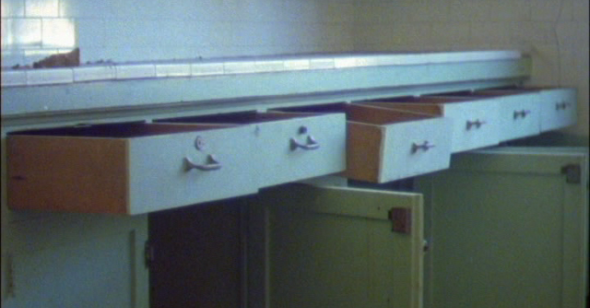Ghost World
by Farihah Zaman
California Company Town
Dir. Lee Ann Schmitt, U.S., self-distributed
California Company Town is an unusual creature in the world of modern documentary film, particularly among the more politically oriented of the species. It is shot on 16mm, has no characters, no interviews, and consists of so many still shots that it most closely resembles experimental landscape films, such as those of Peter Hutton. The film so accurately depicts many decades of past Americas and stitches together so many pieces of history that it feels like a bit of a throwback itself, steeped in nostalgia, and with the pace and sound of a different era. This is not necessarily a bad thing, but an indication of the film’s penchant for Americana—odd, a little out-of-date, and all the better for it.
In this deceptively simple film essay, director Lee Ann Schmitt guides the audience through the folk histories of 23 towns that were once filled with the promise of industry and now languish after its departure, shockingly overgrown, rusted, used up, and left behind. Established largely in the earlier half of the 20th century around natural resources like lumber, oil, and metal mines, the towns are methodically introduced to the audience one by one, represented by a collage of lingering, mostly still shots of nature and old machinery, iconic archival footage, bits of ephemera, and snippets of music and talk radio. The flat, matter-of-fact voice of the narrator in these segments provides a counterpoint to the slow march of mesmerizing imagery, seamlessly shifting back and forth between the broader national context and peculiar, intimate stories that give a sense of each town as a distinct entity.
Seemingly unrelated details skillfully establish the sense of communities lost and the poignancy in their demise—like the fact that this is the first time the circus has returned to Buttonwillow in decades, but the lions and elephants have died and they’re left with only goats and ponies, or that the once-thriving lumber industry in McCloud used to short-change their black and Italian workers and is now owned by a company that makes only library pencils. Schmitt has a gift for imparting information economically. Marked by a relentlessly measured pace and consistently somber tone, California Company Town is more than just a tale of a few communities, however, or even the state of California—its many stories aggregate to form a larger picture of industry, capitalism, and their place throughout the history of America in the 20th century. From Manzanar, established in the Forties as a Japanese internment camp, to the Eighties Cold War fears of Palmdale, where 40 percent of the population worked for the U.S. Defense Department, to a finale that features the remnants of Nineties dot-com mecca Silicone Valley, many concerns of the last 100 years are represented here. Each town remains like a snapshot of the era in which it was suddenly abandoned.
Schmitt seems to have an eye for seeking out little anachronistic bits of history that remain within these disintegrating civilizations with the diligence of an archaeologist. Shots of grandiose mountains and massive rusting machinery are balanced with funny road signs or empty interiors, ripped wallpaper, pamphlets and paintings from a bygone era. The cinematography is lovely, perfectly framed, and employs an unexpected color palette that quietly makes a point about the transience of human life by featuring manmade objects such as dwellings, industrial machinery, and abandoned bric-a-brac in muted pastels while the grass and sky radiate with a nearly neon intensity.
The sound in California Company Town is as thoughtful and meaningful as the imagery (if not as direct), particularly Schmitt’s reliance on archival radio. Radio’s relevance in society has been waning for decades, a fate further sealed by the advent of digital sound, and its obsolescence is reflective of the towns depicted in the film. At points the sound and images work in tandem to envelop the viewer in a particular mood; in the largely Mexican agricultural town of Arvin we hear Spanish pop music and educational recordings on farming, and the aptly named town of Boron, now a U.S. Air Force test site, features the sound of automated Air Force security. Occasionally some aural surprise will break up the news radio or time-capsule tunes, such as a piece of dark choral music in Eagle Mountains, which the narrator reveals to be a recording of the final graduating class of that town, one which had been allowed to continue on through commencement although the nearby mine had closed.
At other instances Schmitt’s uses juxtaposition to make wry observations. In Kaweah, shots of the idyllic trees of a now-national forest are interrupted by the narrator explaining that the community was based on ideas of collective ownership and had changed the name of a major redwood from General Sherman to Karl Marx; line-dancing tourists in the former silver mine town of Calico are paired with the voice of Ronald Reagan describing how grand America is in a promotional film funded by the Richfield Oil Company. With these carefully placed combinations of sound and imagery, Schmitt manages to weave her various stories together into one coherent narrative, at turns grand and intimate, a looming vision of the Wild West as cozy as a family scrapbook.
Schmitt skillfully maintains the unique identities of these towns, while also effectively conveying the bigger picture: this is a country in which large corporations are given so much power that entire towns collapse with them when they fail. The film’s breadth is partly a function of the sheer number of towns that Schmitt visited over the course of her five years of filming and research, of seeing their company woes gradually laid out over time. It’s also a result of her idiosyncratic, well-curated imagery, sound bites, and historical anecdotes, which function as more than just interesting bits of trivia—they’re synecdoches for the state of America.
